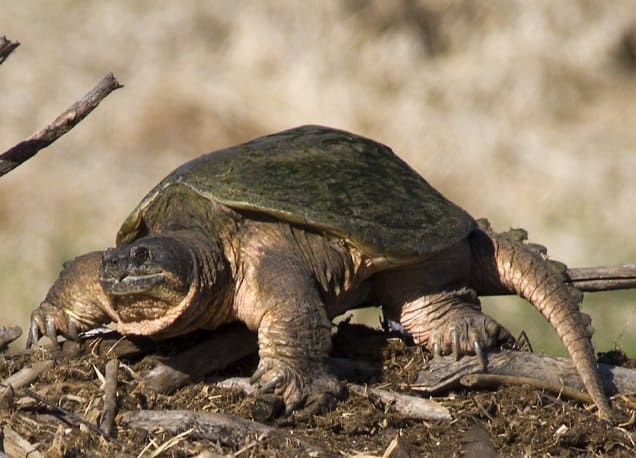If you like snakes, Utah’s your place. The state has a whopping 31 species of snakes! Although it has a hot, dry climate, Utah also has over 2,000 lakes. At many of these, you’ll encounter some of Utah’s beautiful snake species. So, which lakes are “infested” with snakes? None of them! An “infestation” is a population of wildlife so large that it causes damage or the spread of disease. In this sense, no lake in Utah is infested with snakes. The snakes that live in the state’s water bodies are part of a healthy ecological balance. But some Utah lakes are particularly known for providing habitat to abundant snake populations. We’ll tell you all about them, in case you want to go there to admire these beauties yourself . . . or, more than likely, avoid them completely!
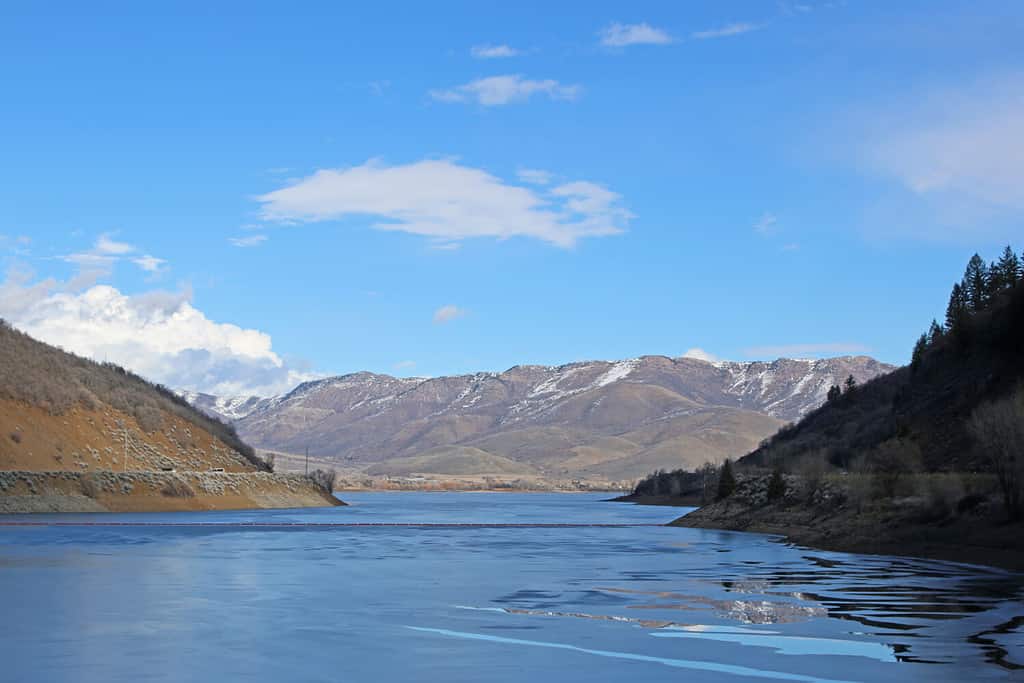
Utah has over 2,000 lakes, including Pineview Reservoir.
©Greens and Blues/Shutterstock.com
Common Snakes Near Utah’s Lakes
What we commonly refer to as “water snakes” are of the genus Nerodia, which are not native to Utah. However, many species of snakes linger near lakes and even take to the water in search of food or to escape from predators. Here are some of the most common snakes you could encounter on a vacation at one of Utah’s lakes:
Great Basin Rattlesnake
The great basin rattlesnake (Crotalus oreganus lutosus) is a subspecies of the western rattlesnake. It lives in the farms, plains, and canyons of western Utah. It grows over 5 feet long and is venomous. Note however that only a few people die of rattlesnake bites in the United States every year. Most people who do get bitten provoke the snake in some way, getting too close and trying to catch it or kill it. If you get bitten, rinse the wound with clean water, keep it elevated above heart level, and seek timely medical care and you’ll be fine. Incidentally, do not cut the bite with a knife or try to suck out the poison. These traditional ideas are no longer recommended by experts.
Maybe it’s surprising to think a rattlesnake would frequent the water, but in fact, some of Utah’s lakes are surrounded by rock formations that make ideal hiding places for rattlesnakes. They will go into the water to rehydrate themselves, to catch prey near the shore, or to cross short distances to get where they’re going or escape from predators. So, if you’re ever boating and see a stick float by, look twice and make sure it’s really a stick! The great basin rattlesnake can be distinguished by its pale gray, olive-brown, or yellowish-brown color with dark patches that have pale centers running down their backs. They are useful in the environment for keeping down populations of squirrels, rabbits, rats, and mice.
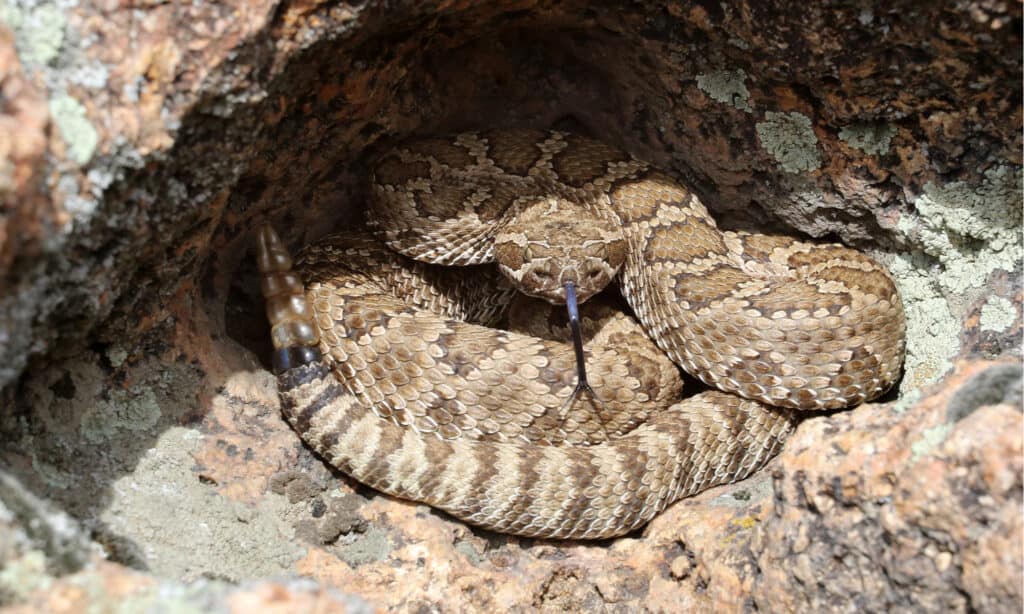
©Randy Bjorklund/Shutterstock.com
Black-Necked Garter Snake
The black-necked garter snake (Thamnophis cyrtopsis) lives in Southern Utah. They have dark bodies with an orange-colored stripe down their backs and large black patches at the base of their skulls, giving their head the appearance of a black heart. Their bodies are covered with small cream or white spots that look like dashes. These vibrantly colored snakes are non-venomous carnivores that eat mainly small fish, amphibians, and invertebrates.
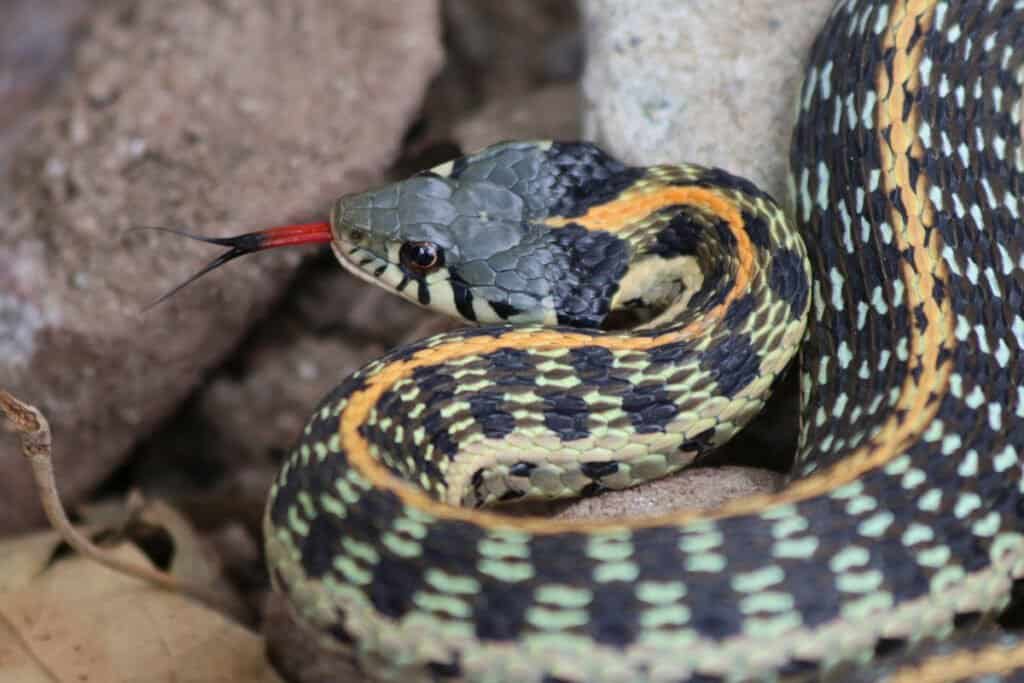
The black-necked garter snake has beautiful and distinctive coloration.
©Creeping Things/Shutterstock.com
Western Terrestrial Garter Snake
The western terrestrial garter snake (Thamnophis elegans) is a small species averaging 11-23 inches (30-60 cm) long. They can be olive green or brown with white, yellow, or green stripes running lengthwise down their bodies. Their venom is mild and harmless to humans but lethal to small prey such as invertebrates, small fish, frogs, and lizards. They often hunt in grassy areas near a water source.
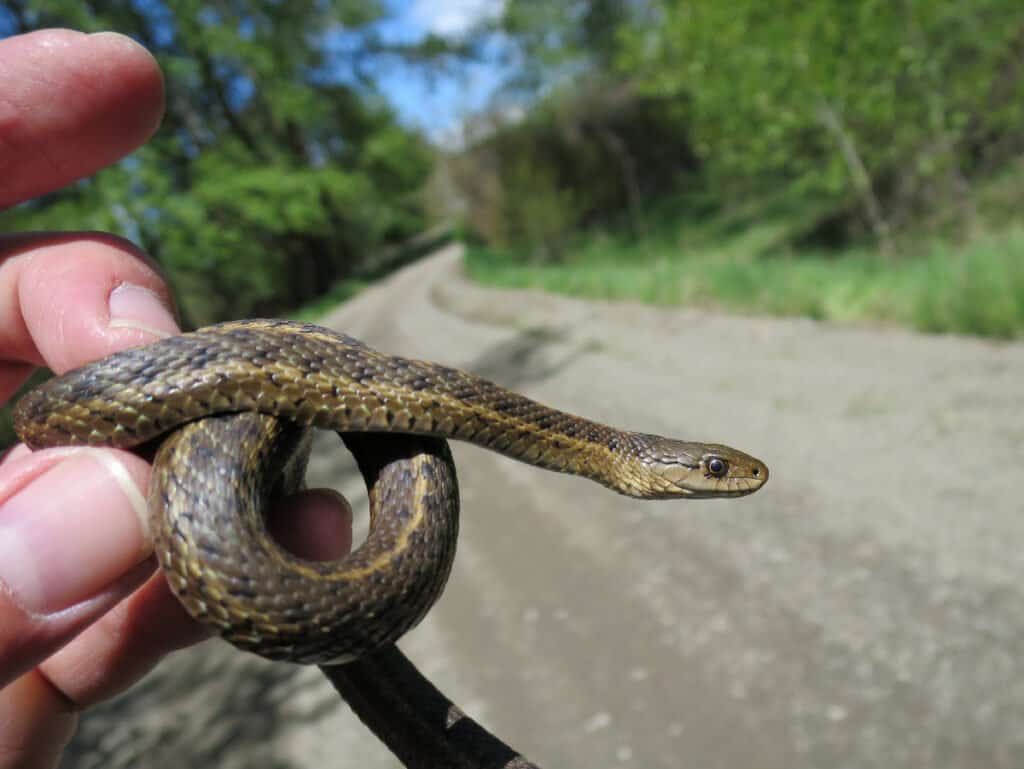
The western terrestrial garter snake has a mild venom that is harmless to people but lethal to small prey.
©Randy Bjorklund/Shutterstock.com
Valley Garter Snake
The valley garter snake (Thamnophis sirtalis fitchi) is one of the most beautiful snakes you’ll spot around Utah’s lakes. They are dark brown or black with a bright yellow or greenish stripe running along their spines. The underbelly is yellow, or cream-colored and red or orange spots punctuate their sides. They grow to about 17-27 inches (45-70 cm) long. As a non-venomous species, this snake eats fish, frogs, and insects.
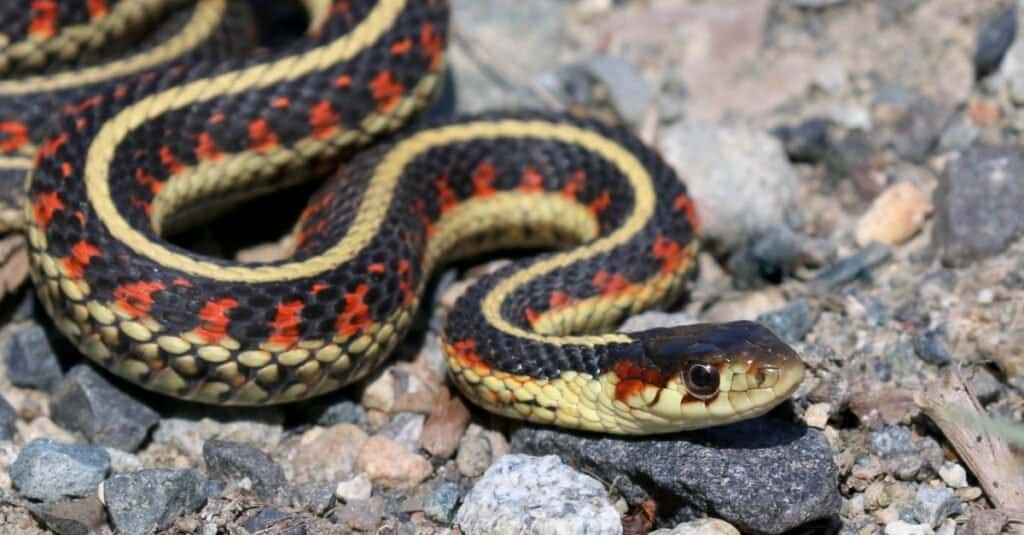
Valley garter snakes have beautiful, distinctive markings.
©iStock.com/randimal
Great Basin Gopher Snake
The great basin gopher snake (Pituophis catenifer deserticola) is intimidatingly large. Fully mature males can reach up to 8 feet long! Never fear, though, as these are non-venomous snakes that usefully feed on pests like mice and rats as well as other small mammals, birds, and reptiles. They have large heads and eyes. Their coloration is a splotchy pattern of cream-tan, light brown, and dark brown, black. This helps them stay camouflaged among leaves and rocks. This species is often confused with the great basin rattlesnake because of their similar color and markings and the habit of the gopher snake of twitching its tail when it is under threat. A way to tell the difference is that the rattlesnake looks fatter and has a triangle-shaped head while the gopher snake is thin and has a more conical or bullet-shaped head.
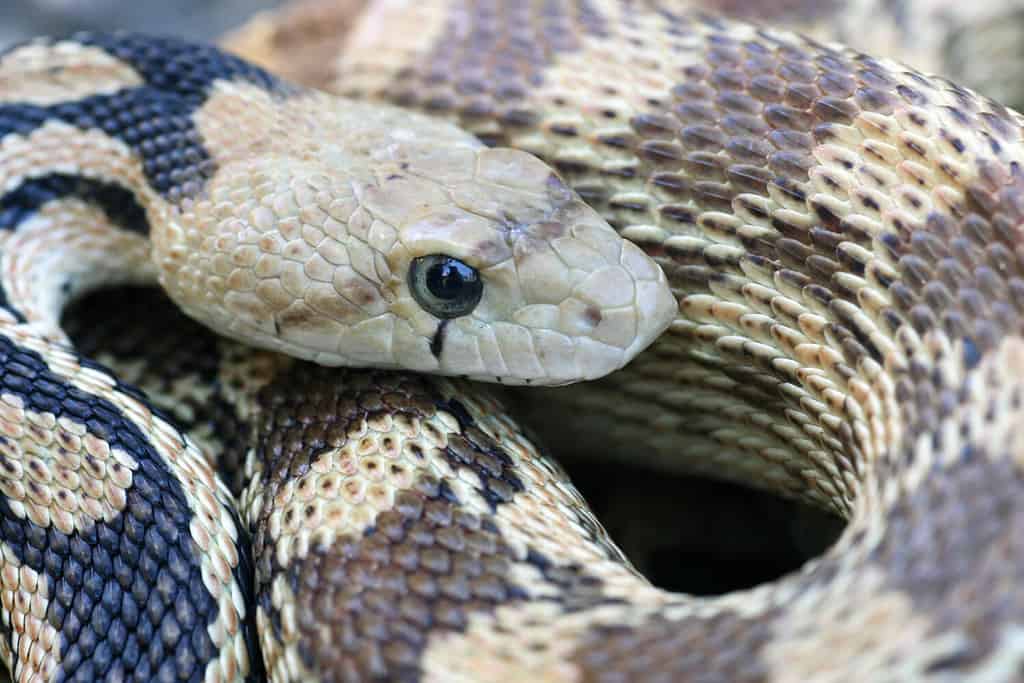
The great basin gopher snake is large and scary looking, but non-venomous.
©Michael Benard/Shutterstock.com
Western Yellow-Bellied Racer
The western yellow-bellied racer (Coluber constrictor mormon) is a subspecies of the eastern racer. They can reach up to 5 feet long and have narrow heads and long, slim bodies that come in solid shades of black, grey, blue, or olive-brown. They get the name “yellow-bellied” from the fact that their underbellies are light yellow to white. Racers live in a lot of diverse habitats, from dry sunny areas, woodlands, fields, and thickets, but they also frequent marches, bogs, and the edges of lakes. Young ones eat insects, spiders, small frogs, and young rodents. Adults eat birds and their eggs, small rodents like squirrels and young rabbits, small turtles, and other snakes. Racers are non-venomous, but they do like to vibrate their tails in dry leaves to impersonate rattlesnakes.
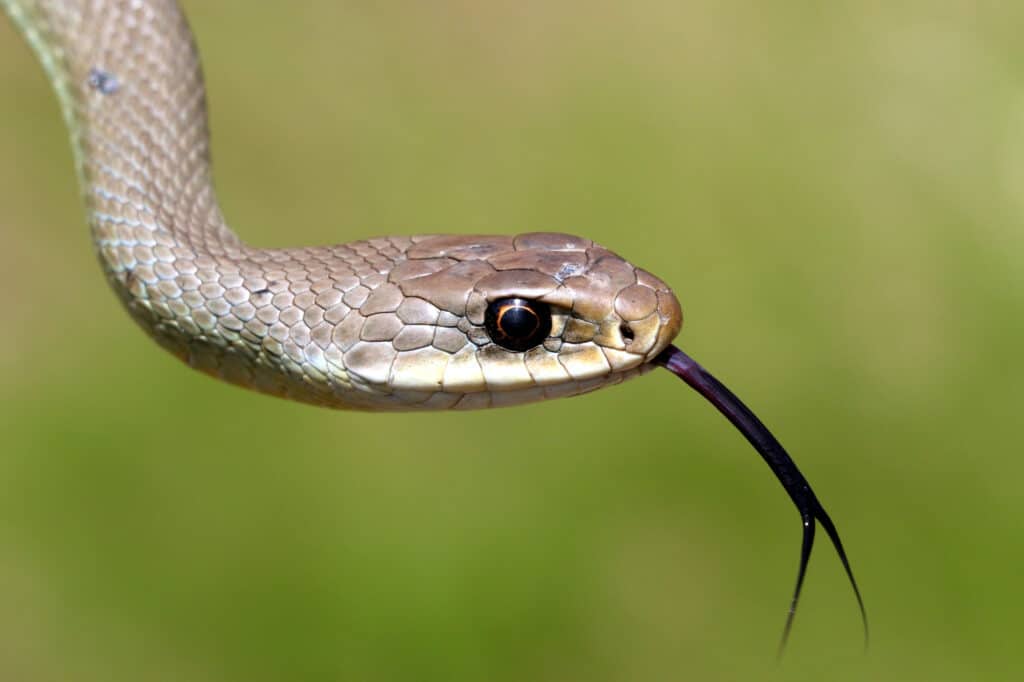
A western yellow-bellied racer (
Coluber constrictor mormon), sampling its environment with its tongue.
©iStock.com/randimal
Southwestern Black-Headed Snake
The southwestern black-headed snake (Tantilla hobartsmithi) is a small, slender snake that grows to about 8 inches long. They’re light brown all over with a black head, giving them their name. They are harmless to people. If you have them in your garden, consider yourself fortunate. They nest under moist leaves, rocks, and debris and eat insects like spiders and centipedes as well as earthworms. Because they like moist places, they’re also found near rivers, streams, and lakes.
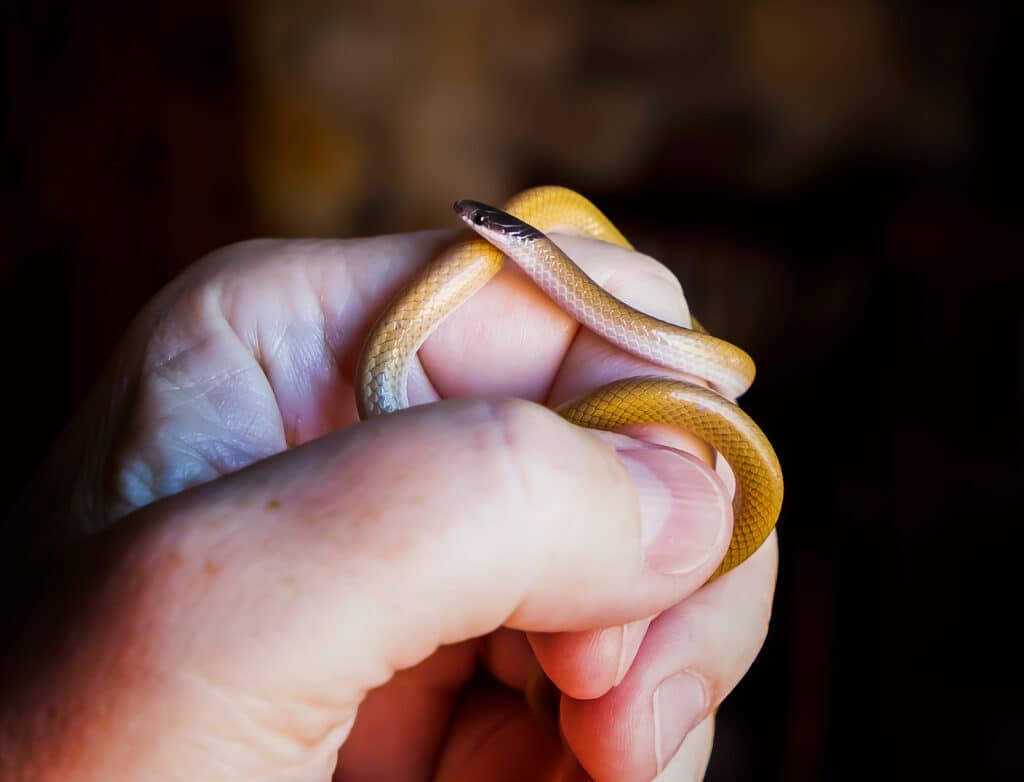
The southwestern blackhead snake prefers wet habitats with loose soil, like stream beds.
©Erin Donalson/Shutterstock.com
Ring-Necked Snake
The ring-necked snake (Diadophis punctatus) is another reptile that inhabits the marshy areas near some Utah lakes. They’re harmless and defend themselves by curling up in a ball and displaying the bright yellow-orange or red underside of their tails. On their dorsal side, ring-necked snakes are dark olive, brown, blue-gray or black with a yellow, red, or yellow-orange band around their necks. Adults can grow to 15 inches long. They are nocturnal and eat small snakes, lizards, frogs, and other similarly sized prey.
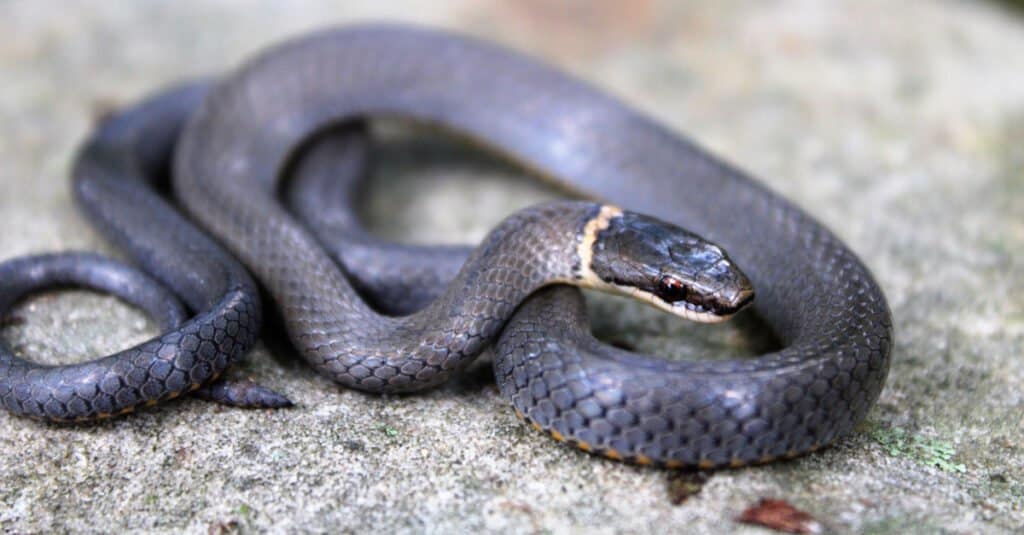
Ring-necked snakes feed on smaller snakes, amphibians, and lizards near some of Utah’s lakes.
©Tucker Heptinstall/Shutterstock.com
5 Most Snake-Infested Lakes in Utah
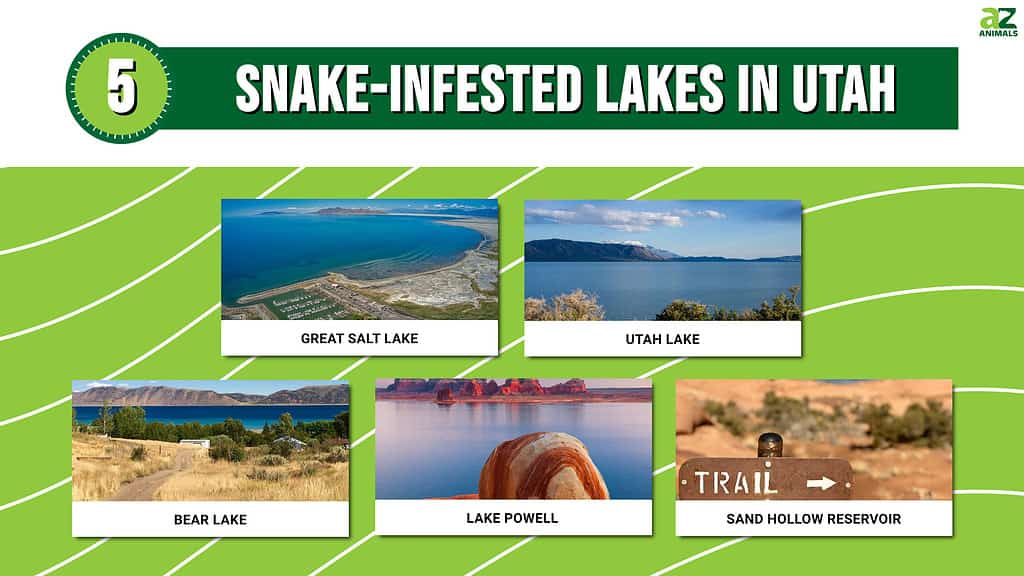
Let’s learn about the most “snake-friendly” lakes in the state!
1. The Great Salt Lake
The Great Salt Lake is the largest saltwater lake in the Western Hemisphere. Really, it’s more of an inland sea surrounded by gleaming salt flats. Given the high salinity levels of the area, you might assume there would be no snakes. However, garter snakes, racers, and others live in the brackish marshes and wetlands near the lake. Don’t be surprised if you’re exploring the area to see the occasional snake sunbathing on a rock.
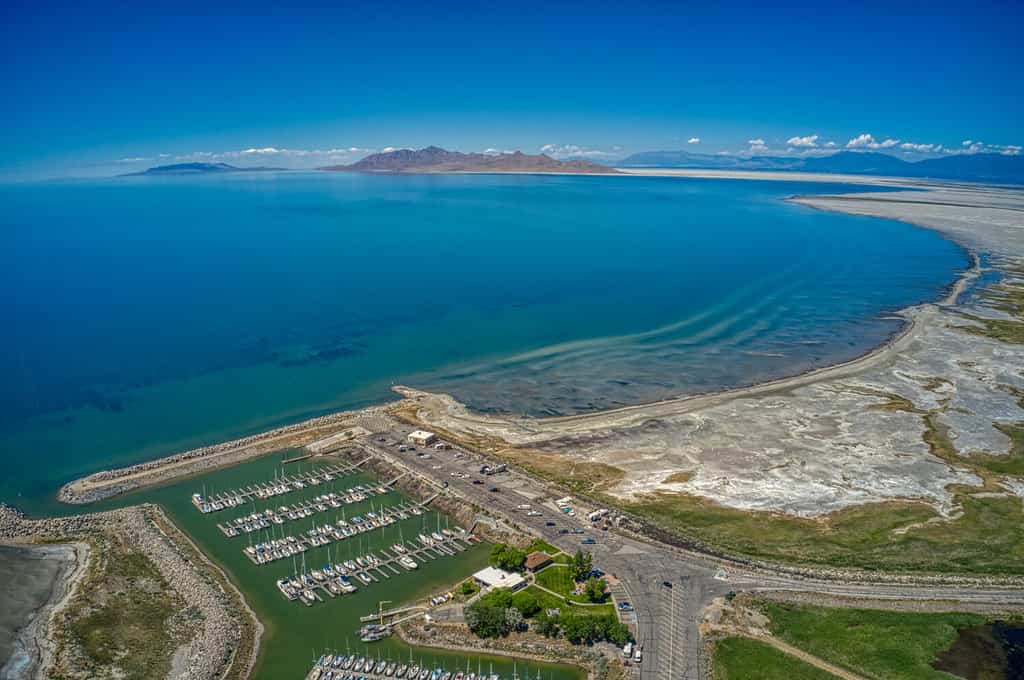
The marshes and wetlands of the Great Salt Lake provide habitat for several snake species.
©Jacob Boomsma/Shutterstock.com
2. Utah Lake
Utah Lake is the second-largest natural freshwater lake in the state. It’s popular for nature lovers, fishing, boating, and other watersports. The fish population includes channel catfish, walleye, and largemouth bass. The marshy shores are home to several snake species that thrive in diverse habitats. You can find garter snakes, racers, and the bullsnake along the shores of this freshwater lake. Bullsnakes can grow up to 6 feet long and can be intimidating, but they are non-venomous.
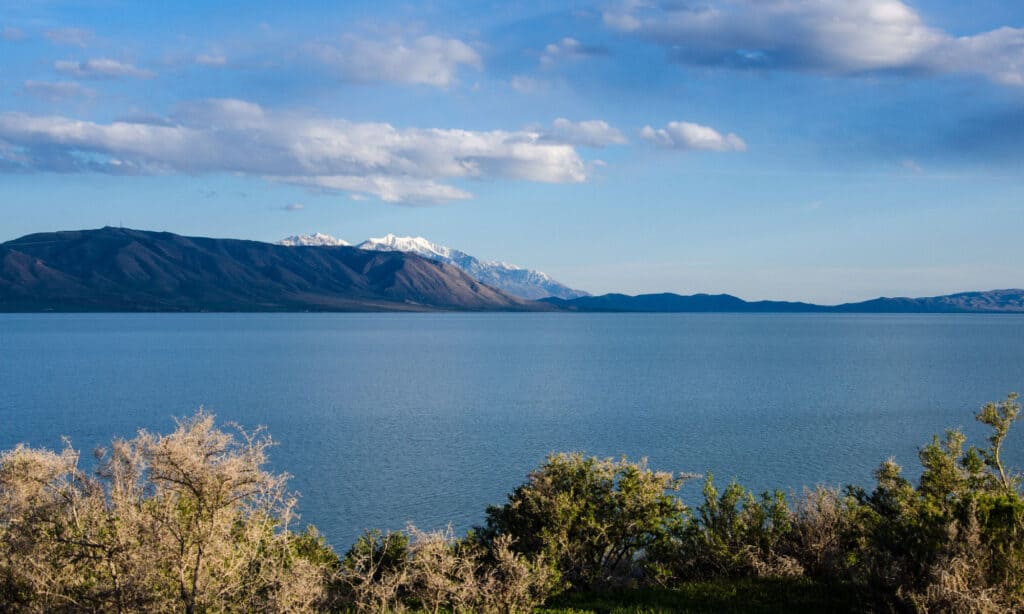
Utah Lake offers impressive mountain views.
©iStock.com/craigpickup
3. Bear Lake
Sitting on the Utah-Idaho border, Bear Lake is the deepest lake in Utah. It’s reputable for its pristine turquoise waters, thriving fish populations, and recreational opportunities. Harmless garter snakes slither near the shoreline.
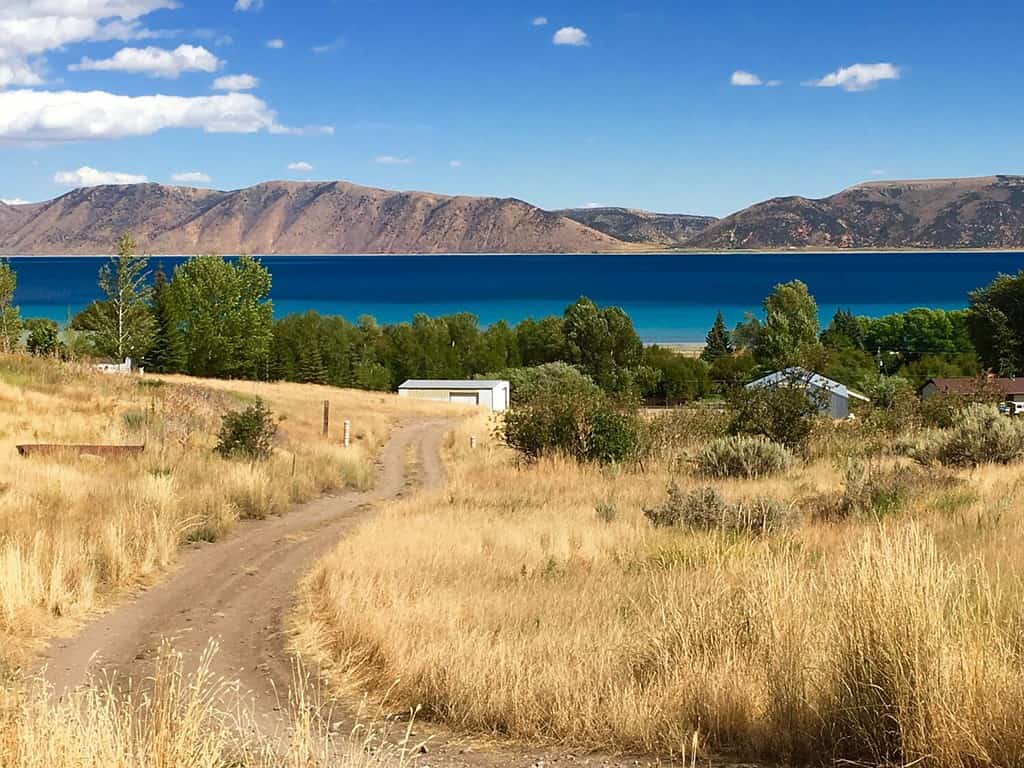
Bear Lake is located on the Utah-Idaho border.
©Joe Farah/Shutterstock.com
4. Lake Powell
Lake Powell lies on the Colorado River, where the Glen Canyon Dam impounds the water. It stretches across the Utah-Arizona border and offers beautiful red rock scenery and recreation such as boating and fishing as well as camping and hiking around the shoreline. Various snake species inhabit the rocky areas surrounding the lake. The lake’s long shoreline through desert terrain offers spots for snakes to dwell. So, be on the lookout for the occasional rattlesnake besides the gopher snake.
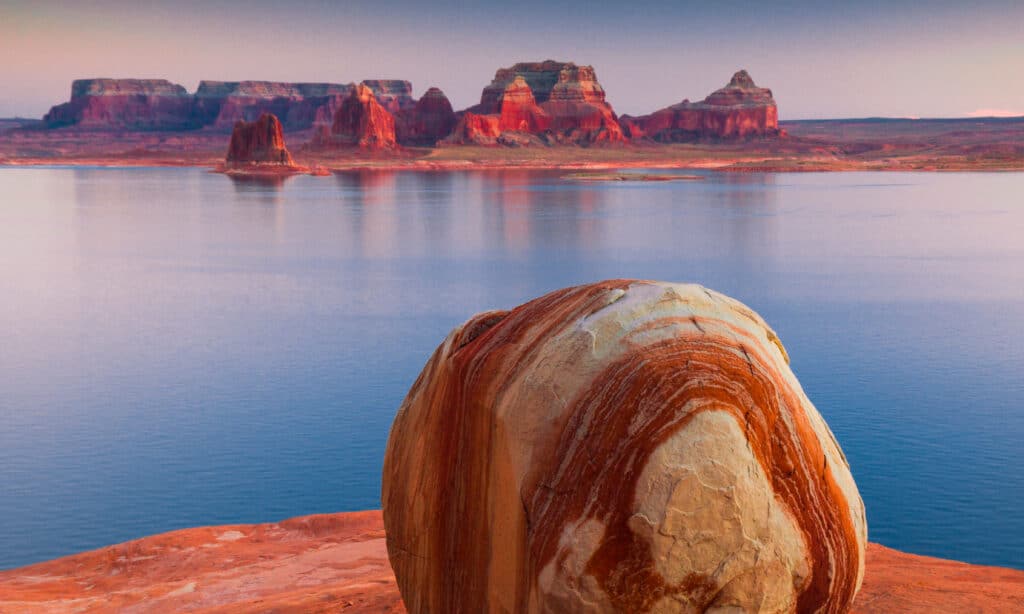
Lake Powell, Utah is famed for its Mars-like red rock formations.
©iStock.com/Lucas Cometto
5. Sand Hollow Reservoir
Situated near Hurricane in Southwestern Utah is Sand Hollow Reservoir. It provides a refreshing retreat for water enthusiasts. The surrounding desert areas may offer encounters with rattlesnakes and gopher snakes. They are frequent around campsites, trails, and rocky or brushy spots. hence, be mindful of these creatures as you explore the canyons and lakeshore beaches.
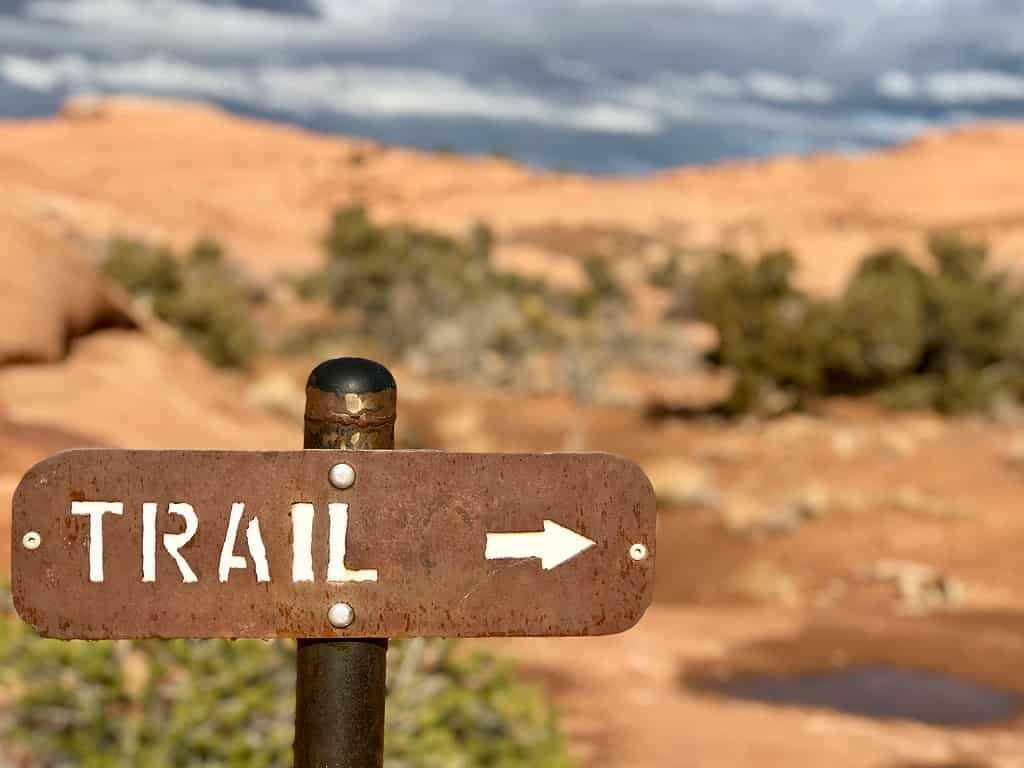
Red sand deserts similar to this in Sand Hollow Reservoir provide habitat for several snake species.
©wildJune/Shutterstock.com
Other Animals Found Near Lakes in Utah
While you’re looking out for snakes, you might encounter the following creatures in the vicinity of Utah’s lakes as well:
Birds
Lakes in Utah provide habitat for many species of birds, especially waterfowl. Watch for ducks, geese, swans, grebes, herons, egrets, pelicans, and gulls. Utah has some of the best bird-watching spots you’ll find anywhere. You may spot rare or unusual migratory birds stopping at the lakes in spring and fall.
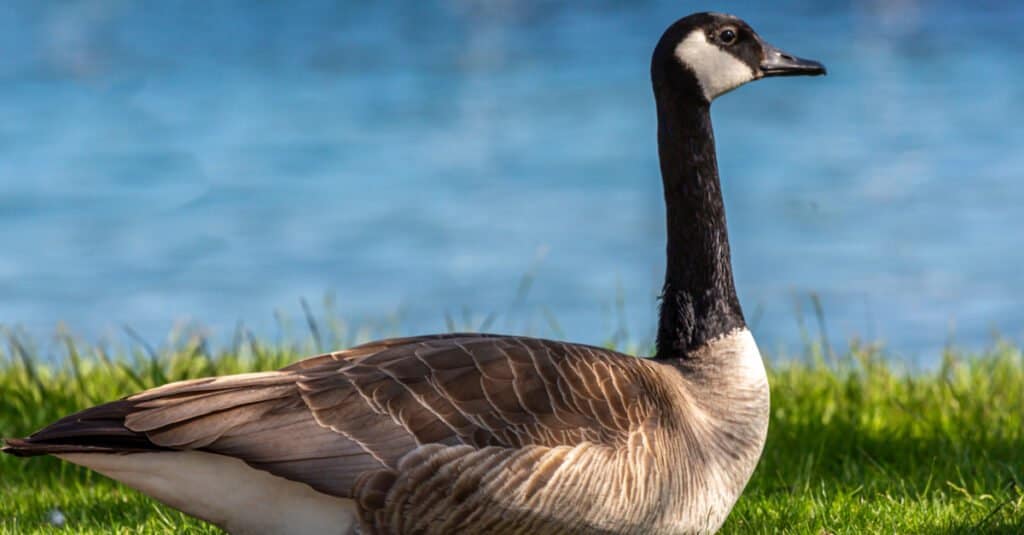
The Canada goose is one of many waterfowl you can spot on Utah’s lakes.
©David McIntosh/Shutterstock.com
Fish
Utah’s lakes contain many types of fish, including trout, bass, catfish, and perch. Utah has over 1,000 fishable lakes in a variety of ecological zones – an angler’s paradise! Be sure to get the proper licenses and follow the rules on catch limits.
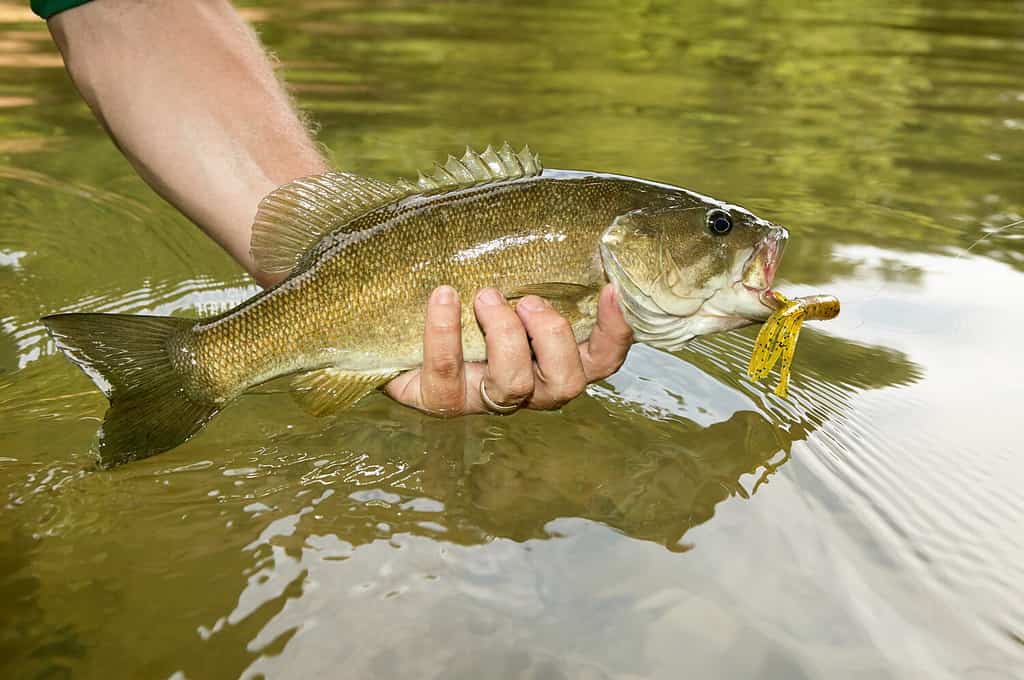
Smallmouth bass are plentiful in some of the lakes of Utah.
©CLP Media/Shutterstock.com
Mammals
Common mammal species around lakes in Utah include beavers, otters, muskrats, deer, coyotes, cougars, and small rodents. You may spot beavers and muskrats swimming in areas where they’ve built lodges and dams. Keep your campsite clean and store food well to avoid attracting coyotes and rodents.
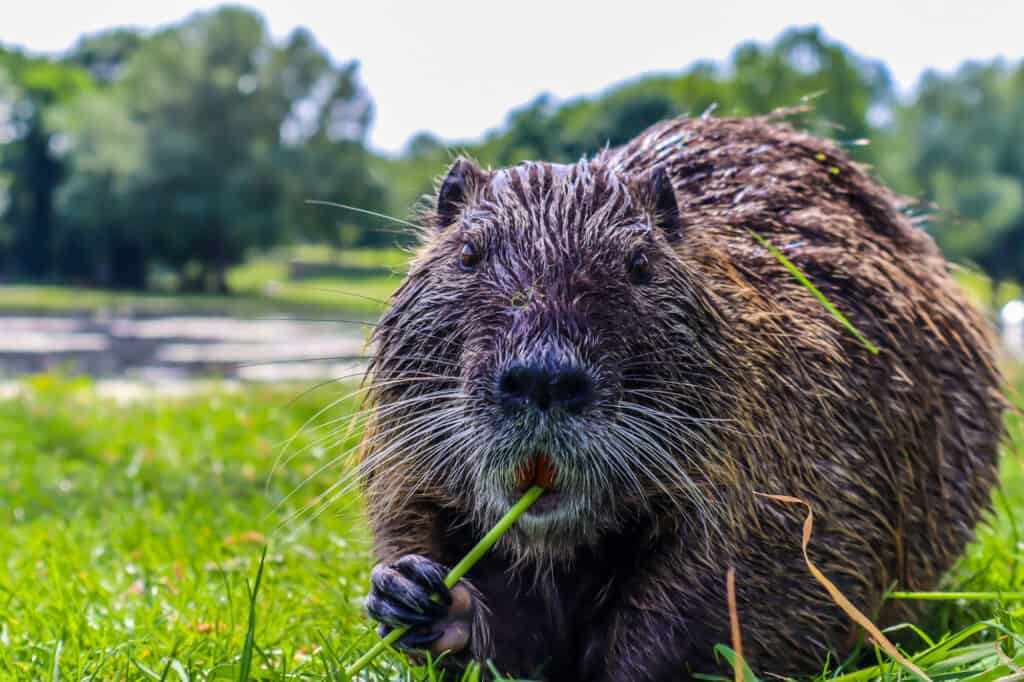
Muskrats are similar to beavers. Both species frequent rivers and other wetlands.
©iStock.com/w1d
Reptiles and Amphibians
Be on the lookout for lizards, turtles, skinks and frogs. Many species of lizards and frogs inhabit the areas around Utah’s lakes. Give turtles plenty of space, and do not disturb them. But you can try eating invasive bullfrogs to help curb their populations!
Insects
Mosquitoes, flies, dragonflies, damselflies, and other insects inhabit regions around lakes. You should use insect repellant in the mornings and evenings when mosquitoes are most active. Check for ticks that transmit Lyme disease or Rocky Mountain spotted fever.
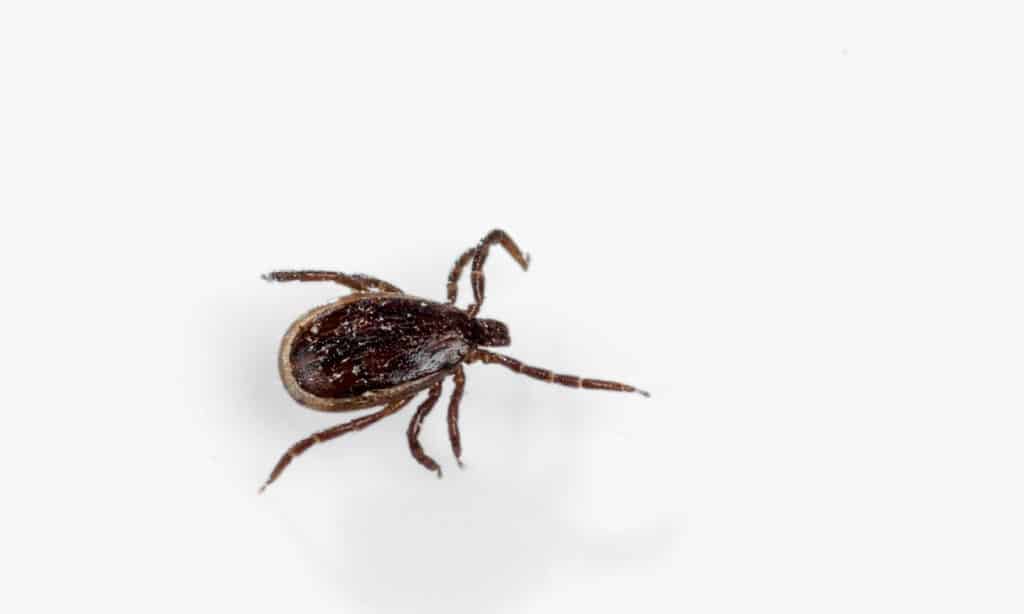
Ticks are a parasitic species that troubles both animals and people.
©iStock.com/VladK213
Your Role in the Ecosystem
Whenever you’re visiting the wilderness, it’s a good time to think about your role in the ecosystem. You’re a visitor in an environment that is not your habitat. This means you will encounter creatures you may have never seen in real life before, including snakes and other species. As a visitor, it is best to observe at a safe distance, and take photos if you want, but don’t disturb the wildlife you find, unless it is actively threatening you. In that case, back away, make some noise, or throw rocks and sticks to scare off the threat. Most of all, remember that whether you personally like a particular animal or not, it has a role to play in the natural balance. And sometimes, when we learn about the creatures we find most scary and threatening, we can understand them better and even see them as wonderful and beautiful.

When it comes to wildlife, we have to remember we are guests in their habitats.
©Mary C L/Shutterstock.com
Summary of the 5 Most Snake-Infested Lakes in Utah
| Name | Location | Common Snakes Nearby |
|---|---|---|
| Great Salt Lake | Next to Salt Lake City on the west/northwest | Garter snakes, racers, and more. |
| Utah Lake | Next to Provo on the west and south of Salt Lake City | Garter snakes, racers, and bullsnakes. |
| Bear Lake | Northeast of Logan, crossing the Utah-Idaho border | Garter snakes. |
| Lake Powell | On the Colorado River at Glen Canyon Dam, crossing the Utah-Arizona border | Rattlesnakes and gopher snakes. |
| Sand Hollow Reservoir | In southwest Utah, southwest of Hurricane and east of St. George | Rattlesnakes and gopher snakes. |
The photo featured at the top of this post is © Tucker Heptinstall/Shutterstock.com
Discover the "Monster" Snake 5X Bigger than an Anaconda
Every day A-Z Animals sends out some of the most incredible facts in the world from our free newsletter. Want to discover the 10 most beautiful snakes in the world, a "snake island" where you're never more than 3 feet from danger, or a "monster" snake 5X larger than an anaconda? Then sign up right now and you'll start receiving our daily newsletter absolutely free.
Thank you for reading! Have some feedback for us? Contact the AZ Animals editorial team.



